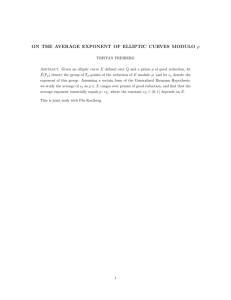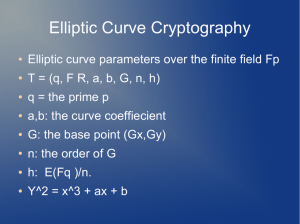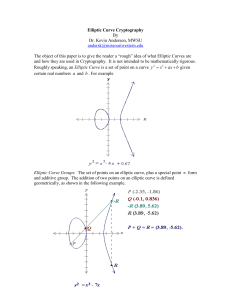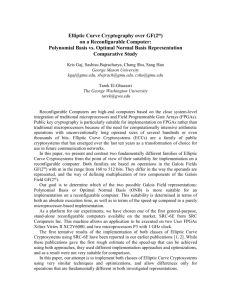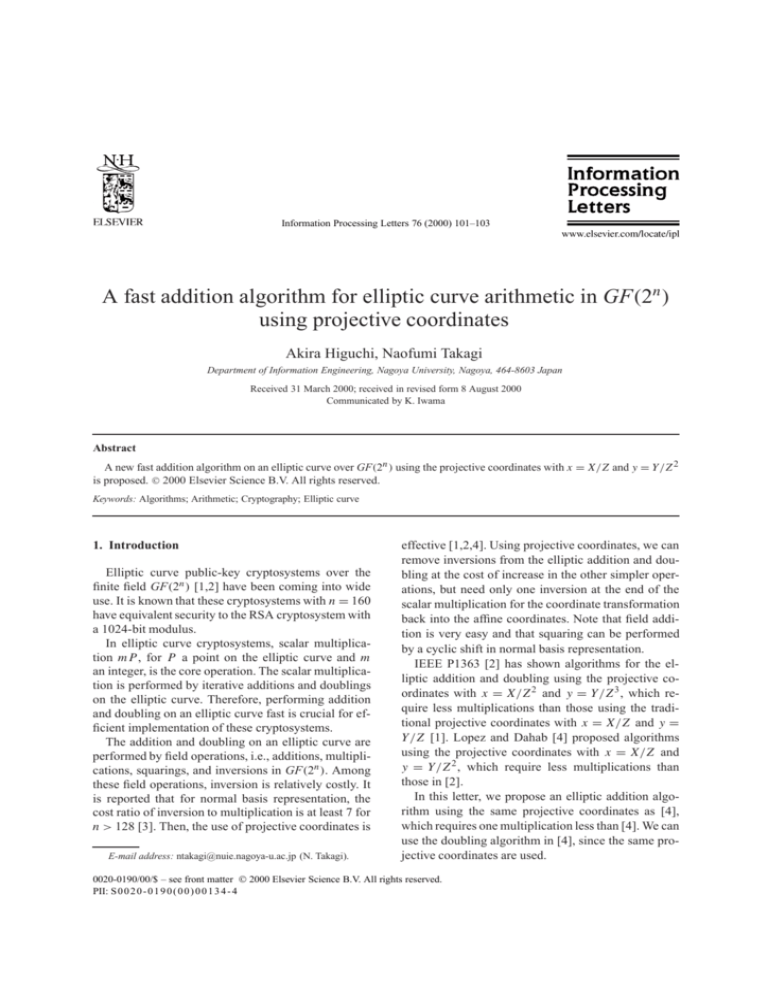
Information Processing Letters 76 (2000) 101–103
A fast addition algorithm for elliptic curve arithmetic in GF(2n)
using projective coordinates
Akira Higuchi, Naofumi Takagi
Department of Information Engineering, Nagoya University, Nagoya, 464-8603 Japan
Received 31 March 2000; received in revised form 8 August 2000
Communicated by K. Iwama
Abstract
A new fast addition algorithm on an elliptic curve over GF(2n ) using the projective coordinates with x = X/Z and y = Y/Z 2
is proposed. 2000 Elsevier Science B.V. All rights reserved.
Keywords: Algorithms; Arithmetic; Cryptography; Elliptic curve
1. Introduction
Elliptic curve public-key cryptosystems over the
finite field GF(2n ) [1,2] have been coming into wide
use. It is known that these cryptosystems with n = 160
have equivalent security to the RSA cryptosystem with
a 1024-bit modulus.
In elliptic curve cryptosystems, scalar multiplication mP , for P a point on the elliptic curve and m
an integer, is the core operation. The scalar multiplication is performed by iterative additions and doublings
on the elliptic curve. Therefore, performing addition
and doubling on an elliptic curve fast is crucial for efficient implementation of these cryptosystems.
The addition and doubling on an elliptic curve are
performed by field operations, i.e., additions, multiplications, squarings, and inversions in GF(2n ). Among
these field operations, inversion is relatively costly. It
is reported that for normal basis representation, the
cost ratio of inversion to multiplication is at least 7 for
n > 128 [3]. Then, the use of projective coordinates is
E-mail address: ntakagi@nuie.nagoya-u.ac.jp (N. Takagi).
effective [1,2,4]. Using projective coordinates, we can
remove inversions from the elliptic addition and doubling at the cost of increase in the other simpler operations, but need only one inversion at the end of the
scalar multiplication for the coordinate transformation
back into the affine coordinates. Note that field addition is very easy and that squaring can be performed
by a cyclic shift in normal basis representation.
IEEE P1363 [2] has shown algorithms for the elliptic addition and doubling using the projective coordinates with x = X/Z 2 and y = Y/Z 3 , which require less multiplications than those using the traditional projective coordinates with x = X/Z and y =
Y/Z [1]. Lopez and Dahab [4] proposed algorithms
using the projective coordinates with x = X/Z and
y = Y/Z 2 , which require less multiplications than
those in [2].
In this letter, we propose an elliptic addition algorithm using the same projective coordinates as [4],
which requires one multiplication less than [4]. We can
use the doubling algorithm in [4], since the same projective coordinates are used.
0020-0190/00/$ – see front matter 2000 Elsevier Science B.V. All rights reserved.
PII: S 0 0 2 0 - 0 1 9 0 ( 0 0 ) 0 0 1 3 4 - 4
102
A. Higuchi, N. Takagi / Information Processing Letters 76 (2000) 101–103
2. Elliptic curves over GF(2n )
=
A non-supersingular elliptic curve E over GF(2n )
is defined to be the set of solutions (x, y) ∈ GF(2n ) ×
GF(2n ) to the equation
y 2 + xy = x 3 + ax 2 + b,
(1)
where a and b ∈ GF(2n ), b 6= 0, together with the
point at infinity denoted by O. E forms a commutative
finite group, with O as the group identity, under the
addition operation shown below. Let P = (x0 , y0 ) and
Q = (x1 , y1 ) be points of E (P 6= Q). Then, P + Q =
(x2 , y2 ) is calculated as
y0 + y1 2 y0 + y1
+
+ x0 + x1 + a,
(2)
x2 =
x0 + x1
x0 + x1
y2 =
y0 + y1
(x0 + x2 ) + x2 + y0 .
x0 + x1
(3)
2P = (x2 , y2 ) is calculated as
b
,
x02
y0
2
x2 + x2 .
y2 = x0 + x0 +
x0
x2 = x02 +
If we perform addition and doubling according to
these formulae, each of them requires a field inversion.
3. A new addition algorithm
We use the same projective coordinates as [4],
where x = X/Z and y = Y/Z 2 . Then, the elliptic
curve E becomes the set of solutions (X, Y, Z) ∈
GF(2n ) × GF(2n ) × GF(2n ) to the equation Y 2 +
XY Z = X3 Z + aX2 Z 2 + bZ 4 . Note that the points
with Z = 0 satisfying this equation, i.e., (X, 0, 0),
correspond to the point at infinity, O.
In order to obtain a new addition algorithm, we
transform (2) as follows.
y0 + y1 2 y0 + y1
+
+ x0 + x1 + a
x2 =
x0 + x1
x0 + x1
(y0 + y1 )2 + (y0 + y1 )(x0 + x1 )
=
(x0 + x1 )2
(x0 + x1 )3 + a(x0 + x1 )2
+
(x0 + x1 )2
y02 + y12 + x0 y0 + x0 y1 + x1 y0 + x1 y1
(x0 + x1 )2
+
x03 + x02 x1 + x0 x12 + x13 + ax02 + ax12
.
(x0 + x1 )2
Since y02 + x0 y0 = x03 + ax02 + b and y12 + x1 y1 =
x13 + ax12 + b from (1), y02 + y12 + x0 y0 + x1 y1 + x03 +
x13 + ax02 + ax12 = 0. Therefore,
x0 y1 + x1 y0 + x02 x1 + x0 x12
.
(4)
(x0 + x1 )2
Let P = (X0 , Y0 , Z0 ) and Q = (X1 , Y1 , Z1 ) be
points of E (P 6= Q). Then, P + Q = (X2 , Y2 , Z2 )
is calculated as
X2 = X0 Z1 Y1 Z02 + (X1 Z0 )2
(5)
+ X1 Z0 Y0 Z12 + (X0 Z1 )2 ,
x2 =
Y2 = X0 Z1 (Y0 Z12 + Y1 Z02 )(X0 Z1 + X1 Z0 )
+ Y0 Z12 (X0 Z1 )2 + (X1 Z0 )2
× (X0 Z1 )2 + (X1 Z0 )2
+ (Y0 Z12 + Y1 Z02 )(X0 Z1 + X1 Z0 ) + Z2 X2 ,
(6)
2
2
(7)
Z2 = Z0 Z1 (X0 Z1 ) + (X1 Z0 ) .
We can derive these formulae as follows. First, we
determine (7) so that no inversion is required for
the calculations of X2 and Y2 . Then, we obtain (5)
and (6) by substituting x = X/Z and y = Y/Z 2 to (4)
and (3), and transforming them using (7), respectively.
Note that (X0 Z1 + X1 Z0 )2 = (X0 Z1 )2 + (X1 Z0 )2 in
GF(2n ).
Therefore, we can perform the addition by the
following calculations.
A0 = X0 Z1 ,
A1 = X1 Z0 ,
B0 = A20 ,
B1 = A21 ,
C = A0 + A1 ,
D = B0 + B1 ,
E0 = Y0 Z12 ,
E1 = Y1 Z02 ,
A. Higuchi, N. Takagi / Information Processing Letters 76 (2000) 101–103
Table 1
The number of field operations for elliptic addition (( ): when a = 0
or 1)
Z1 6= 1
#mul. #sqr.
Z1 = 1
#mul. #sqr.
Algorithm
Projective
coordinates
IEEE [2]
X/Z 2 , Y /Z 3
15 (14)
5
10 (9)
4
Lopetz [4]
X/Z, Y /Z 2
14 (13)
6
10 (9)
4
Proposed
X/Z, Y /Z 2
13
4
10
3
F = E0 + E1 ,
G = F C,
Z2 = Z0 Z1 D,
X2 = A0 (E1 + B1 ) + A1 (E0 + B0 ),
Y2 = (A0 G + E0 D)D + (G + Z2 )X2 .
The proposed addition algorithm requires 13 multiplications and 4 squarings. When Z1 = 1, it requires
10 multiplications and 3 squarings.
Table 1 shows a comparison of elliptic addition
algorithms with respect to the number of required field
operations. When one of the two coefficients defining
the elliptic curve, a, is 0 or 1, the addition algorithms
of [2] and [4] require one multiplication less than in
the other cases. The proposed addition algorithm is the
fastest when a is not 0 nor 1.
Since the same projective coordinates are used,
we can use the known fastest doubling algorithm
proposed in [4] which requires 5 multiplications (4
when a is 0 or 1) and 5 squarings.
103
When we use the simple double-and-add method for
scalar multiplication, mP , we need log2 m doublings
and on average 12 log2 m additions. Therefore, when a
is not 0 nor 1, using the proposed addition algorithm,
we obtain an improvement of about 4.2% compared
with [4].
4. Conclusion
We have proposed a fast addition algorithm on an
elliptic curve over GF(2n ) using the projective coordinates with x = X/Z and y = Y/Z 2 . It requires one
less multiplications than the known fastest algorithm.
We can use the known fastest doubling algorithm proposed in [4], since the same projective coordinates are
used.
References
[1] A. Menezes, Elliptic Curve Public Key Cryptosystems, Kluwer
Academic Publishers, Dordrecht, 1993.
[2] IEEE P1363, Standard Specifications for Public Key Cryptography, 1999, http://grouper.ieee.org/groups/1363/.
[3] J. Guajardo, C. Paar, Efficient algorithms for elliptic curve
cryptosystems, in: Advances in Cryptology, Proc. CRYPT’97,
Lecture Notes in Comput. Sci., Vol. 1294, Springer, Berlin,
1997, pp. 342–356.
[4] J. Lopez, R. Dahab, Improved algorithms for elliptic curve
arithmetic in GF(2n ), in: Selected Areas in Cryptography, Proc.
SAC’98, Lecture Notes in Comput. Sci., Vol. 1556, Springer,
Berlin, 1998, pp. 201–212.




